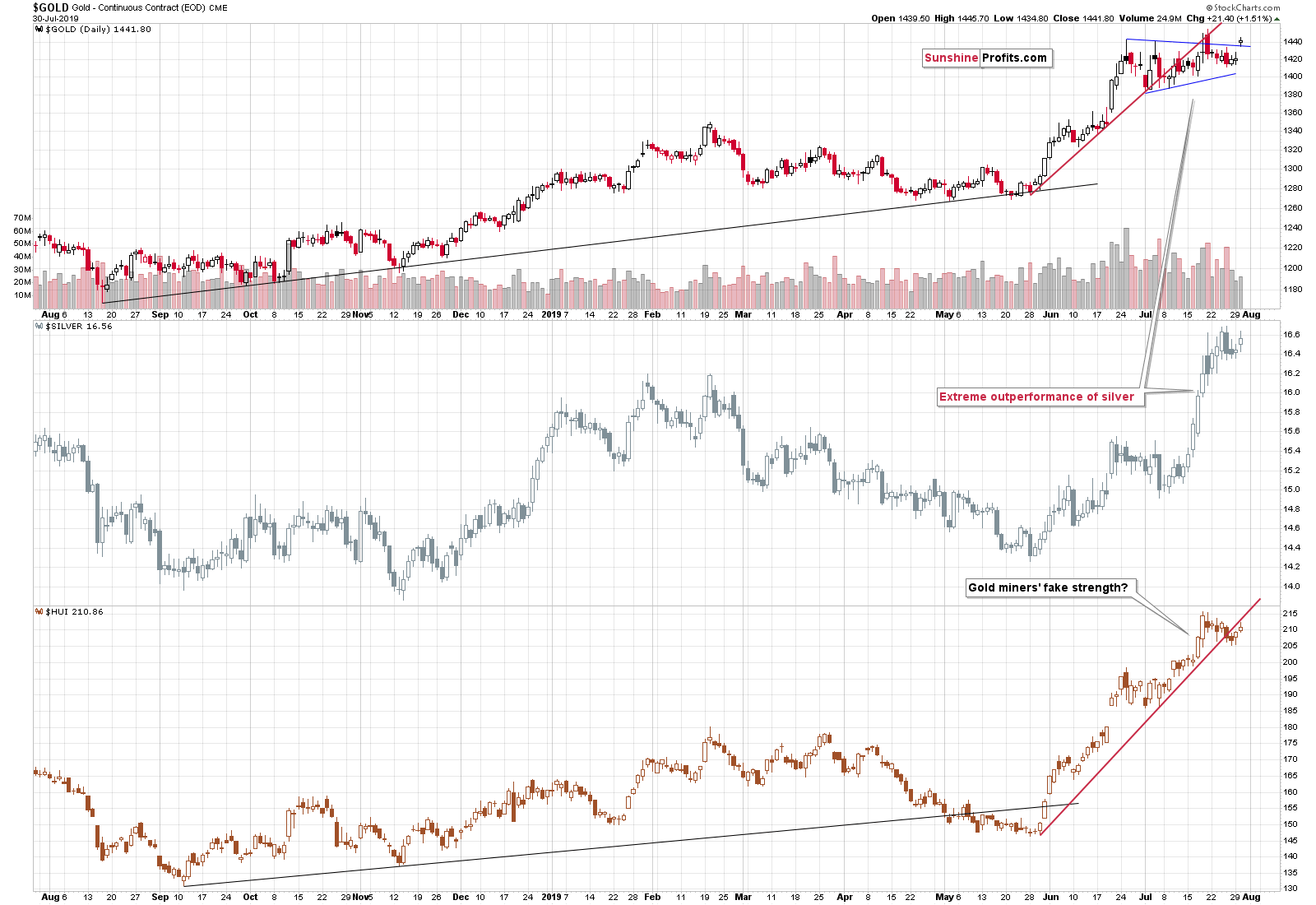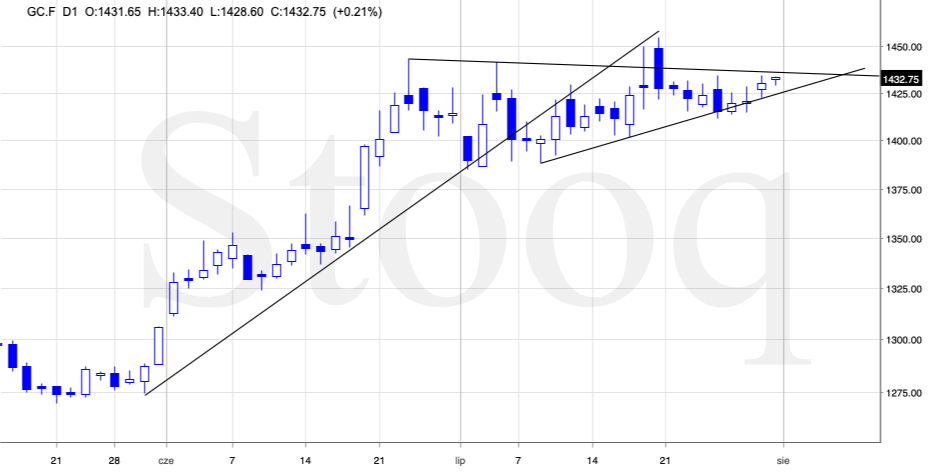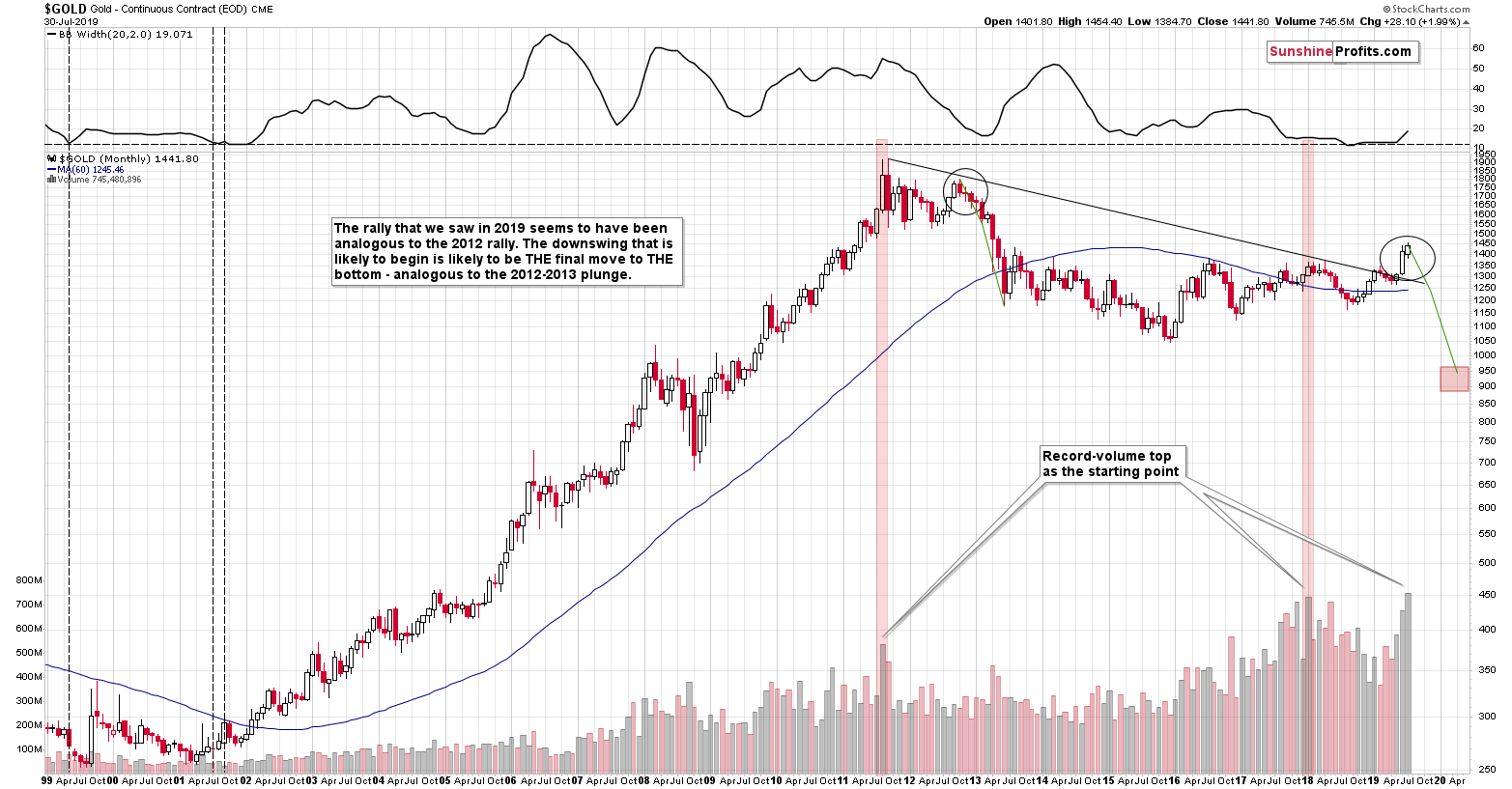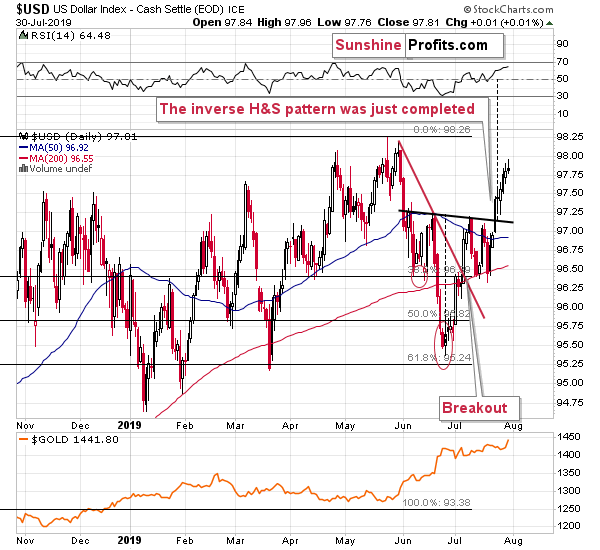Briefly: in our opinion, full (250% of the regular size of the position) speculative short position in gold, silver, and mining stocks is justified from the risk/reward perspective at the moment of publishing this Alert.
The great day of the Fed interest rates decision and forward guidance has arrived. There hasn't been much pre-positioning volatility in the precious markets so far. With the exception of gold perhaps, you might say. Let's dive in and assess whether a technically important gold move has happened yesterday, or not. Examination of the other markets will show us whether it's the real deal, or not.
In yesterday's Alert, we warned you about the upcoming volatility preceding the Fed interest rate decision and the following press conference. So far, we seen relatively little volatility, but it was already notable. More could follow and it's now particularly important to stay focused on what really matters - the trends and technical signals that we saw before the forthcoming news-driven dust settles.
In gold, we saw an invalidation of the breakout above the pennant pattern. In silver, we saw exceptional strength in the short term. Gold miners broke below their rising support line and just verified the breakdown below it. This is a bearish combination, even if we don't take into account the multiple similarities between now and the late 2012 top in the entire precious metals sector, especially the ones in silver (the same retracement) and the ones in the gold stocks to gold ratio that we explained yesterday.
Checking Yesterday's PMs Action
While gold miners certainly closed below their rising support line and there was no new breakout in silver, it seems that gold once again broke above the pennant pattern. But...
It's not really the case.
Looking at gold futures based on a more detailed chart from a different chart provider, we get a different picture - there was no breakout. The outlook certainly could become bullish in the following days and weeks, but it's unlikely and it hasn't happened yet.
Silver's move may appear to be making the silver forecast bullish, but please note that the white metal already gave up yesterday's gains entirely at the moment of writing these words.
To be honest, there's not much that we can add in today's short-term analysis to what we wrote yesterday, but since the month is almost over and the key comments from the Fed are to be released today, we would like to speculate a bit about where the month could end and what it might imply.
The Gold Chart Scenarios
Even though the month is not yet over, we can already see that the volume that accompanied the July price change was huge. Actually, it's an understatement. It is the biggest monthly volume ever. The other two major monthly volume levels were recorded right at the 2011 top and at the 2018 top (in terms of the monthly closing prices). This alone is something that should make you question the logic behind buying gold now as opposed to buying it after a sizable price decline takes place.
But there's actually more to the big volume than the above. We mentioned this gold trading tip numerous times, but it's worth repeating once again. The reversals, for instance the shooting star candlesticks, need to be confirmed by sizable volume in order to be reliable. The volume is already extreme.
Wait, we don't have any reversal candlestick just yet.
That's true, but today is the final day of the month, and it's the day when the Fed provides critical clues and that means that gold could change its course quite rapidly. It's certainly possible that gold rallies based on the - likely - interest rate cut, but let's keep in mind that gold might actually decline even though the Fed is likely to lower the interest rates. Why? Because practically everyone expects the rates to be lowered, while some investors expect them to be lowered by 50 basis points, not just 25. They are likely to be disappointed (the Fed is unlikely to shoot a bazooka as a warning, insurance shot), which means that the interest rate decision - even though it is likely to be a rate cut - might be actually viewed as something hawkish. Again - not because it is such per se, but because it is hawkish compared to the average expectations.
Quite a lot will depend on what the Fed says during the press conference, so the final part of today's session will likely be quite volatile. And the implications of the entire monthly price changes will depend on it. The volume is already huge, so it will confirm what happens in terms of price. If gold rallies, we will have a conflict between bearish implications of huge volume per se, and bullish implications of a rally on big volume. But, when gold reverses this month, the extreme volume will make the gold reversal very, very, very profound.
There's one more thing that we would like to discuss about the Trump - Fed conflict regarding interest rates. Trump wants lower dollar in order to boost U.S. exports, economic numbers, and stock prices - the last two are the statistics that will be used to measure the success of his presidency. And he definitely wants it to look as good as possible - that's why he's been pressing so hard for lower interest rates instead of higher ones.
Let's see what happened after the Fed changed its course and bowed to the pressure.
The expectations regarding interest rates are already much lower. But is the U.S. dollar lower?
Framing the USD Index
It's not. Of course, the U.S. currency reacted just as it was supposed to - initially. It declined based on dovish comments. But, once it was all said and done (mostly said), the USD soared back up. It's now very close to its yearly high, even though the expectations regarding interest rates are entirely different.
The Fed sees that lowering rates didn't work and - most importantly - so does Trump. It either already became obvious to him or it will become obvious that the market forces are too strong to keep the U.S. currency at low levels. What then?
Replying to this question is difficult when we think about the economic environment, geopolitics, and financial markets. But it's easy when we get back to the likely core of the decision to keep the dollar lower in the first place.
Trump wants to look good and wants his presidency to be viewed as successful and that's why he wants the lower U.S. dollar. What if we can't get it no matter what he does (which appears to be the case)? Then there's only one thing left to do. Find something or someone else to blame, while allowing the inevitable (rallying USD) to happen. The Fed lowered interest rates? Maybe it didn't lower them soon or significantly enough. Trade war with China? Europe? Or maybe Mexico or the war drums beating on Iran? There will definitely be someone to blame for declining stock market and soaring USD. Trump said so many times that he wants lower USD that if anything unpleasant (plunging stock prices?) happens, it's very easy to blame it on too high USD, which is fault of everyone except him (right?).
The bottom line is that USD's rally is definitely possible despite the current political setups and so is gold's decline.
Summary
Summing up, the breakdown in the gold stocks, the multiple signals coming from the silver market and strong bearish indications from the gold stocks to gold ratio clearly confirm that the rally in the precious metals sector has most likely already ran its course. Moreover, let's keep in mind that gold has recently invalidated its breakout above the previous highs, the late-2013 highs, and the upper border of the pennant pattern, which is also a very strong bearish sign. The situation in the currency market confirms the bearish outlook for the PMs. In those circumstances, we simply cannot forecast gold at higher levels in the medium term. There will most likely be times when gold is trading well above the 2011 highs, but they are unlikely to be seen without being preceded by a sharp drop first.
Today's sessions could be volatile due to the interest rate decision and the follow-up press conference, but once it's all said and done, the main trend is likely to resume. And the main trend is down.
As always, we'll keep you - our subscribers - informed.
To summarize:
Trading capital (supplementary part of the portfolio; our opinion): Full short position (250% of the full position) in gold, silver, and mining stocks are justified from the risk/reward perspective with the following stop-loss orders and exit profit-take price levels:
- Gold: profit-take exit price: $1,241; stop-loss: $1,468; initial target price for the DGLD ETN: $51.87; stop-loss for the DGLD ETN $30.27
- Silver: profit-take exit price: $13.81; stop-loss: $16.73; initial target price for the DSLV ETN: $39.08; stop-loss for the DSLV ETN $22.87
- Mining stocks (price levels for the GDX ETF): profit-take exit price: $17.61; stop-loss: $29.27; initial target price for the DUST ETF: $32.28; stop-loss for the DUST ETF $6.88
In case one wants to bet on junior mining stocks' prices (we do not suggest doing so - we think senior mining stocks are more predictable in the case of short-term trades - if one wants to do it anyway, we provide the details), here are the stop-loss details and target prices:
- GDXJ ETF: profit-take exit price: $23.71; stop-loss: $43.47
- JDST ETF: profit-take exit price: $73.32 stop-loss: $13.87
Long-term capital (core part of the portfolio; our opinion): No positions (in other words: cash)
Insurance capital (core part of the portfolio; our opinion): Full position
Whether you already subscribed or not, we encourage you to find out how to make the most of our alerts and read our replies to the most common alert-and-gold-trading-related-questions.
Please note that the in the trading section we describe the situation for the day that the alert is posted. In other words, it we are writing about a speculative position, it means that it is up-to-date on the day it was posted. We are also featuring the initial target prices, so that you can decide whether keeping a position on a given day is something that is in tune with your approach (some moves are too small for medium-term traders and some might appear too big for day-traders).
Plus, you might want to read why our stop-loss orders are usually relatively far from the current price.
Please note that a full position doesn't mean using all of the capital for a given trade. You will find details on our thoughts on gold portfolio structuring in the Key Insights section on our website.
As a reminder - "initial target price" means exactly that - an "initial" one, it's not a price level at which we suggest closing positions. If this becomes the case (like it did in the previous trade) we will refer to these levels as levels of exit orders (exactly as we've done previously). Stop-loss levels, however, are naturally not "initial", but something that, in our opinion, might be entered as an order.
Since it is impossible to synchronize target prices and stop-loss levels for all the ETFs and ETNs with the main markets that we provide these levels for (gold, silver and mining stocks - the GDX ETF), the stop-loss levels and target prices for other ETNs and ETF (among other: UGLD, DGLD, USLV, DSLV, NUGT, DUST, JNUG, JDST) are provided as supplementary, and not as "final". This means that if a stop-loss or a target level is reached for any of the "additional instruments" (DGLD for instance), but not for the "main instrument" (gold in this case), we will view positions in both gold and DGLD as still open and the stop-loss for DGLD would have to be moved lower. On the other hand, if gold moves to a stop-loss level but DGLD doesn't, then we will view both positions (in gold and DGLD) as closed. In other words, since it's not possible to be 100% certain that each related instrument moves to a given level when the underlying instrument does, we can't provide levels that would be binding. The levels that we do provide are our best estimate of the levels that will correspond to the levels in the underlying assets, but it will be the underlying assets that one will need to focus on regarding the signs pointing to closing a given position or keeping it open. We might adjust the levels in the "additional instruments" without adjusting the levels in the "main instruments", which will simply mean that we have improved our estimation of these levels, not that we changed our outlook on the markets. We are already working on a tool that would update these levels on a daily basis for the most popular ETFs, ETNs and individual mining stocks.
Our preferred ways to invest in and to trade gold along with the reasoning can be found in the how to buy gold section. Additionally, our preferred ETFs and ETNs can be found in our Gold & Silver ETF Ranking.
As a reminder, Gold & Silver Trading Alerts are posted before or on each trading day (we usually post them before the opening bell, but we don't promise doing that each day). If there's anything urgent, we will send you an additional small alert before posting the main one.
=====
Latest Free Trading Alerts:
Our open position in the Australian dollar has been closed, and at a sizable profit. But the countdown to tomorrow's Fed is on, and it pays not to rest on laurels. The setups in the other currency pairs won't wait, so let's get down to reading the stories they tell.
The Euro Rests at Support As We Count Our Hefty AUD Profits
=====
Thank you.
Sincerely,
Przemyslaw Radomski, CFA
Editor-in-chief, Gold & Silver Fund Manager







